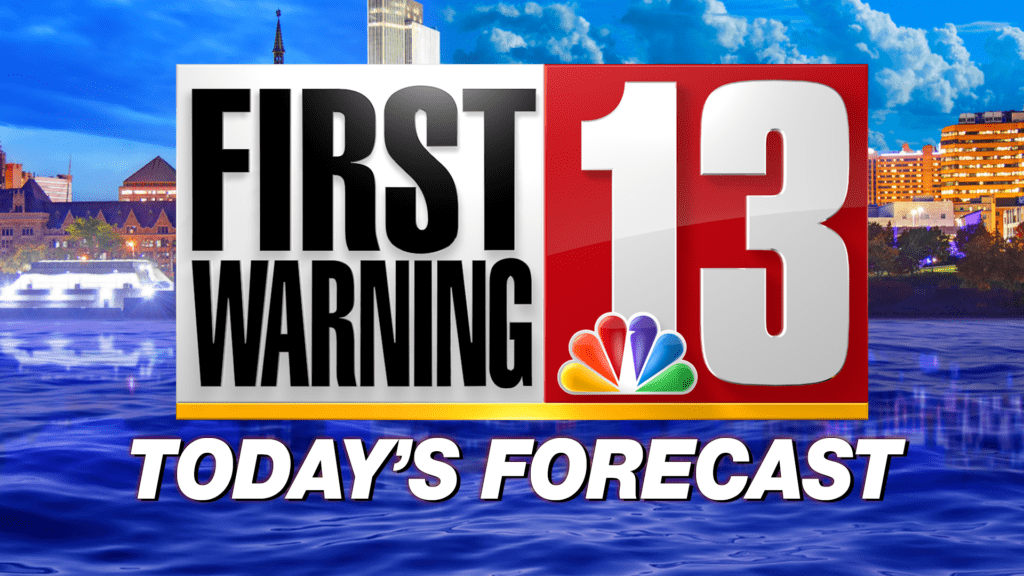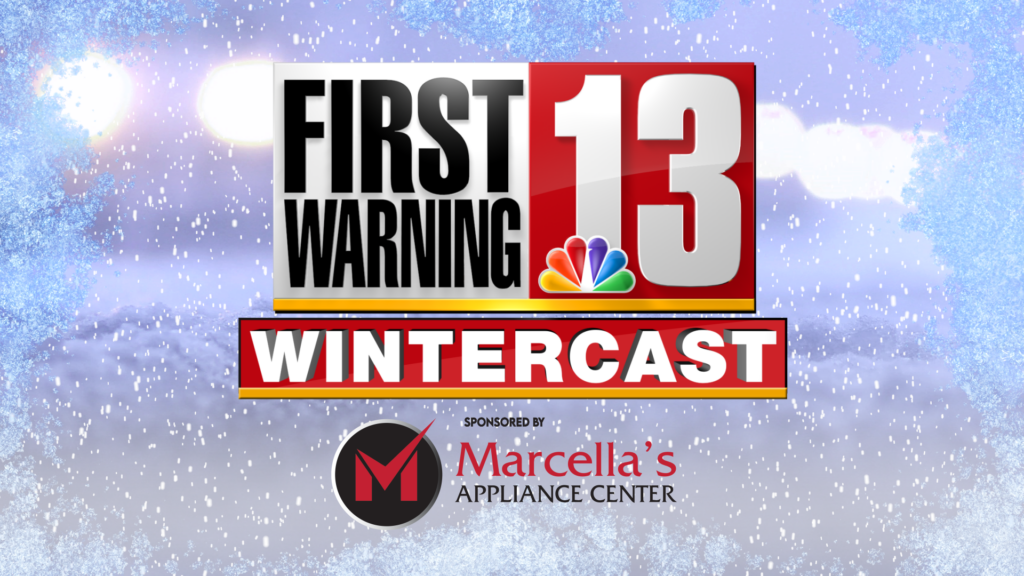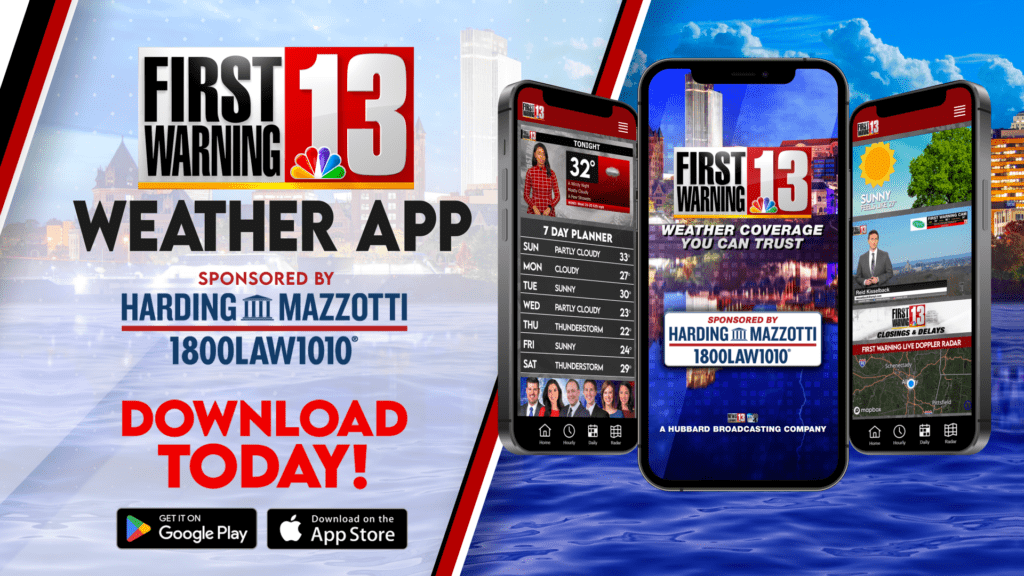
NewsChannel 13 has you covered for winter weather in the Capital Region. Use this guide to prepare.
Cloudy and damp for the rest of the day today with areas of fog and drizzle into the evening. Temperatures will hold in the 40s through sunset. Scattered showers will become more common tonight, with steadier rain developing overnight. It will stay relatively mold with lows will be in the upper 30s and lower 40s.
Tomorrow the last wave of low pressure will move through, bringing more steady and at times heavy rain during the day with highs in the lower 50s. With mild temperatures, melting snow and an event total rainfall ranging between 1-3 inches, some localized flooding is possible. Colder air will flow in behind this system which will turn rain to snow across higher elevations Wednesday evening. Valleys could see a light coat of snow overnight with a couple of inches possible in the hills and mountains.
It will be breezy and much colder on Thursday with scattered snow showers and wind gusts as high as 30mph. Highs will be in the 30s. Friday will be dry but cold with mostly sunny skies and highs near 30.
Have a great afternoon!

HOW TO PREPARE AT HOME
At home, check flashlights and make sure batteries are working. You may wish to purchase a generator in case power is lost during the storm, as it may take a few days to get power back to your home, especially in a rural area.
HOW TO PREPARE OUTSIDE OR AWAY FROM HOME
If you must travel during a winter storm, pack extra clothes (including extra hats and gloves) and a blanket. Also, bring along snacks in case you get stuck in the snow for several hours.

HOW TO PREPARE AT HOME
Inspect your furnace and make sure it is properly working as you don’t want a breakdown or carbon monoxide leak during cold weather. It is not uncommon for an older furnace to break down in the cold.
Additionally, make sure pipes, especially those in the basement, are not frosting up or freezing to avoid a very expensive water pipe burst.
Many hardware stores also sell special products to put over windows to prevent cold drafts. It’s important to use those products, as other items, such as paper or old blankets, can be a serious fire hazard. Air becomes extremely dry with temperatures below zero and this greatly increases the risk for home fires.
Keep extra blankets, clothes, gloves, scarfs, hats and nonperishable foods at home to prepare for any issues related to extreme cold.
HOW TO PREPARE OUTSIDE OR AWAY FROM HOME
Always keep a vehicle’s gas tank about half full to full, as a more full tank is not only better for the engine but also offers you more running time if you become stranded.
Meanwhile, a car battery three years or older should be tested and possibly replaced, as an older car battery will likely fail in temperatures below zero.
Additionally, make sure you have a cold weather kit in your vehicle. You can find tips on how to prepare a kit below.

HOW TO PREPARE AT HOME
One of the best ways to prepare for ice storms and black ice on the roads, is to simply stay up to date with the weather forecast. Some preparations you can take at home to make walking on your driveway or sidewalk safer, is to salt before temperatures fall below freezing. This causes the melt water to dissolve the salt, which lowers the freezing point. When freezing rain or sleet hits the saline solution, it too melts.
When it comes to ice storm warning preparation, you want to be ready for power outages. Ways to prepare for power outages include having a generator ready (outside), food items available, and warm winter clothing and blankets at the ready.
HOW TO PREPARE OUTSIDE OR AWAY FROM HOME
It is always safer for drivers to slow down when this type of weather hits. Try to avoid driving on black ice, but if you are stuck in a situation where you have to drive on black ice, do not brake or slam on the brakes. Instead, lift your foot off the accelerator, with the goal of gently sliding over the ice. You can also shift to a lower gear. It is also recommended that you try to “keep the steering wheel straight” (FSUSDA).
If the car starts to slide in a direction, “make a very gentle turn of the steering wheel in the same direction, because if you struggle against it by steering the opposite direction, you risk skidding or spinning out” (FSUSDA). Look for areas of the road that could provide you with extra traction, and if you do start to skid off the road, try to aim for areas that would involve minimal damage to you, your car and, of course, others. Staying calm is important, and the goal is to get off the road in a black ice situation.

HOW TO PREPARE AT HOME
The NWS advises remaining alert to the latest forecast and travel conditions during a snow squall. The agency also suggests consider avoiding or delaying travel until the snow squall passes.
HOW TO PREPARE OUTSIDE OR AWAY FROM HOME
The NWS advises considering avoiding or delaying travel until the snow squall passes your location. If you must travel, the NWS says to make sure you have plenty of time to get to your destination, as visibility and road conditions can change rapidly. Reduce your speed and turn on headlights, the NWS also suggests.

VEHICLE PREPARATION
Winter increases the risks on roads. It’s important to have the right essentials if anything happens. Below, you can find some important items to have on hand and tips to prepare your vehicle for winter:
Create winter survival kit for your vehicle with the following:
- Jumper cables
- Flares or reflective triangle
- Ice scraper
- Car cellphone charger
- Warm clothes
- Non-perishable food/snacks
- Water
- First aid kit
- Medication (if needed)
It’s also necessary to make sure your car is working properly before winter arrives. Make sure to have a mechanic check antifreeze levels, battery and ignition system, brakes, exhaust system, fuel and air filters, heater and defroster, lights and flashing hazard lights, oil, thermostat, windshield wiper equipment and washer fluid level.
Keep your gas tank full in case of any emergency, have good tires for the winter that work well with snow and ice. Try to avoid flooded areas or areas that have recently flooded as the flood could have weakened roads.
HOW TO PREPARE AT HOME
It’s easy to remember to bundle up when you head outside in these cold temperatures but are you also making sure your pet is prepared?
The American Humane Society suggests the following:
- Keep a pet preparedness kit well-stocked and ready. In the event of a winter storm, pet owners may not be able to leave the home easily to get supplies.
- Keep pets inside, both during the day and night. If dogs are left outside, they should have a draft-free shelter large enough to stand and turn around in, yet small enough to retain body heat. Use straw or bedding material to insulate the shelter.
- Avoid overly grooming pets in the winter, so they have extra fur for warmth. Those who have short-haired pet breeds might consider getting them a coat or sweater that covers them from neck to tail and around the abdomen.
- When walking dogs outside during winter weather, keep them on leash. It’s easier for a dog to become lost in winter storm conditions; more dogs are lost during the winter than during any other season, according to the AHS.
- After going for a walk outside, make sure to wipe a pet’s paws, legs and underside to clean off snow and salt. Check paws, ears and tail for frostbite. Frostbitten skin usually appears pale or gray and can be treated by wrapping the area in a dry towel for gradual warming.
- Avoid allowing your pet to explore lakes and ponds when thin ice is possible. The AHS also advises never trying to rescue a pet that has fallen through the ice – leave that to trained professionals.
- If working to house-train a puppy, remember puppies are more susceptible to cold than adult dogs and paper training indoors may be a better option.
Find even more tips, via the American Society for the Prevention of Cruelty to Animals, about pet care during extreme cold here.

BLIZZARD WATCH VS. BLIZZARD WARNING
The NWS issues blizzard watches when there is a potential for falling and/or blowing snow with strong winds and extremely poor visibility. This can lead to whiteout conditions and make travel very dangerous.
The NWS states blizzard warnings are issued for frequent gusts greater than, or equal to, 35 mph accompanied by falling and/or blowing snow, frequently reducing visibility to less than 1/4 mile for three hours or more. A blizzard warning means severe winter weather conditions are expected or occurring. Falling and blowing snow with strong winds and poor visibilities are likely, leading to whiteout conditions that make travel extremely difficult. The NWS advises against any travel, but if you must travel, have a winter survival kit with you. If you get stranded, stay with your vehicle and wait for help to arrive.
WIND CHILL WATCH VS. WIND CHILL WARNING
According to the NWS, wind chill watches are issued when there is the potential for a combination of extremely cold air and strong winds to create dangerously low wind chill values.
Wind chill warnings, meanwhile, are issued for a combination of very cold air and strong winds that will create dangerously low wind chill values. This level of wind chill will result in frostbite and lead to hypothermia if precautions are not taken. The NWS advises avoiding going outside, and wear warm protective clothing if you must go outside.
OTHER TYPES OF ADVISORIES
You can find information on other types of winter weather, and their related advisories, here.


There’s a lot that goes into forecasting how much snow will fall this winter. We’re taking a closer look at all the factors that help them predict what may happen.
[anvplayer video=”5149346″ station=”998132″]




